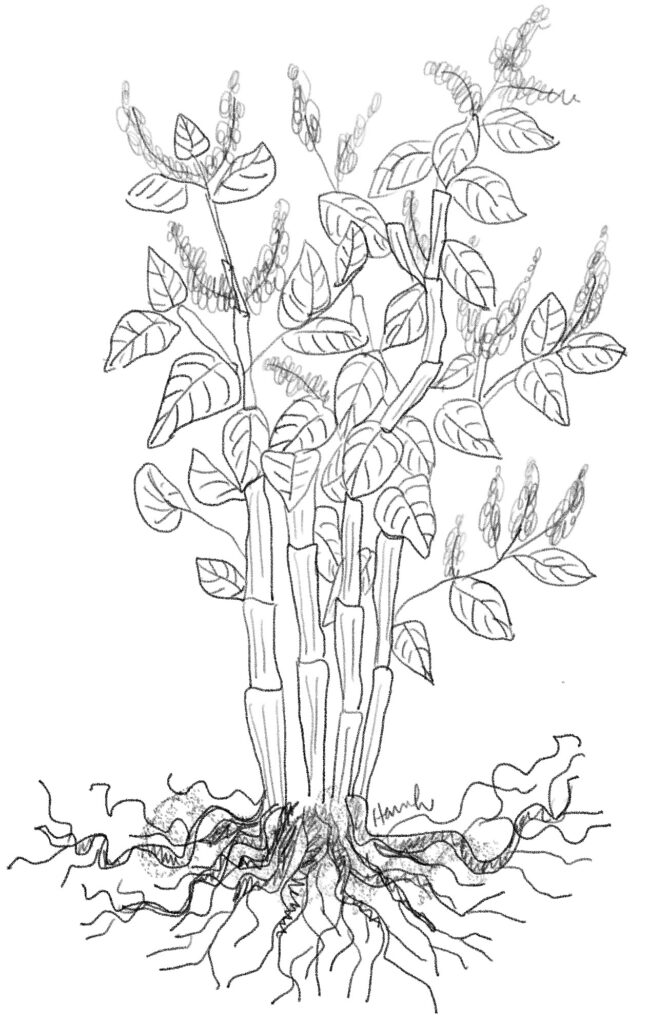Uploaded August 12, 2023

The definition of a beautiful garden has changed many times over. While symmetrical flower beds and trimmed hedges created elaborate living carpets around 16th century castles, by the Victorian era, a more naturalistic garden, with wild flowering shrubs and overgrown meadows was preferred. The wide leafed, purple stemmed Japanese Knotweed, with its fuzzy white flowers and ability to grow fast, tall, and never die was given a gold medal by the Society of Agriculture & Horticulture in 1847 after it was mailed to London in 1850. Philipp Franz Balthasar von Siebold, a German doctor and botanist had found the species near a volcano in Nagasaki, Japan. From then on, he made his business selling Asian plants to Europe, and to gardens all around the world.
By the early 1900s, knotweed was recognized as a problem. Japanese knotweed is allelopathic, meaning it secretes chemicals that inhibit the growth of competitor plants. The word allelopathy comes from two Greek words allelon, meaning “eachother” and pathos, ‘to suffer’. Japanese Knotweed’s chemical secretions reduce seed germination and growth of all neighboring plants, including the diverse range of native plants that our ecosystem depends on.
Japanese Knotweed’s natural habitat is the slopes of volcanoes, where it is one of the first plants to establish after an eruption. Its rhizomatic roots can grow into solid, fresh volcanic rock, and remain for years, even if its stems and leaves above ground are entombed in magma. This means knotweed has no trouble at all growing under sidewalks, roads and the foundation of a house. Because two thirds of the plant is made up of its root system, it will not die when cut, but will instead shoot up new stalks.
There are a lot of different methods practiced to remove Japanese Knotweed, and the Brattleboro Conservation Commission is currently using an approach that involves trimming the stalks when they are young and quarrenting the clippings. The rhizome can spread from fragments of the root or stem in the soil, so a lot of caution must be used when handling the stalks. Always clean and inspect equipment after working in an infested area to prevent transport of plant fragments and seed to new areas. Clippings can be wrapped in black plastic and “baked” in the sun, and then can be disposed of at the transfer station. Some attempt to disrupt the growth cycle of the knotweed by staking a ½ inch metal mesh to the ground after a patch of knotweed has been clipped. This will attempt to choke out the new growth year after year.
Japanese Knotweed management is a multi year process, taking at least 5 years in most cases. Without dedication to eradication, mowing and clipping a knotweed patch could do more harm than help. For links to sources from this article, and more tips about invasive plants in Vermont, visit the Marlboro Conservation Commission page on the town website or email us at MarlboroConservation@gmail.com. Together we can work towards the new definition of a beautiful garden, one that supports a diverse cast of native plants.
Sources:
https://www.bbc.com/future/article/20221006-the-race-to-kill-the-worlds-most-invasive-weed
https://www.mda.state.mn.us/plants/pestmanagement/weedcontrol/noxiouslist/knotweed
https://www.vtinvasives.org/invasive/knotweed-japanese
https://www.permaculturenews.org/2016/01/21/plant-allelopathy/
https://www.michigan.gov/invasives/
https://www.britannica.com/art/garden-and-landscape-design/Western-European
https://www.nps.gov/articles/000/japanese-knotweed-acadia.htm